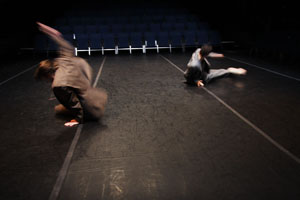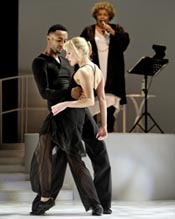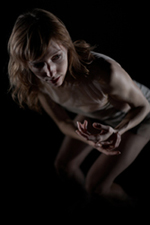In this city of diverse traditions, the promise of experiencing several cultural art forms in one performance tempts the cosmopolitan appetite. For those with such a taste, Turn on the Tap’s “Tappin’ at the Winch: The Resurgence”, at the Winchester Street Theatre, offered a range of flavours. The all-woman company, directed by Toronto tap authority Paula Skimin, presented an ambitious program of physicality and sound from East and West. Although tap dance was the focal point, “The Resurgence” featured bharatanatyam dance by Preethi Gopinath, and a multidimensional soundtrack of blues by the Lush Kings, jazz by singer Raina Ebel and pianist Paul Mason, and Taiko drumming by Brenda Joy Lem.
The presence of these artists points toward the company’s inclusive mandate: to “explore tap dancing with diverse cultures” in a contemporary setting. Artistic Director Skimin invites practitioners of different art forms into the realm of tap dance, to explore a common rhythmic ground on which distinct voices can be heard.
A handful of the pieces left me with deep visual and sonic imprints. “A Sound Happens and You’re Soled”, a collaboration with the Lush Kings, ignites the evening as the company enters in darkness and creates an accelerating soundscape of heavy heels. Sporadic beats resound in the blackness, highlighting the show’s driving force, rhythm. As the tapping gains speed, the glowing lights signal the band and dancers to explode into a percussive interplay between taps and drums. We see these performers at their very best, playful in their reflexive bodies and powerful in their heel-dominant hoofing. Sternums, thighs and shins become percussive sound surfaces for their hands, and the dancers take turns displaying their footwork while their arms swing with ease. Throughout the virtuosic showcase, the group remained integrated — and my senses tingled with the complex syncopations.
The fluidity between the performers was also evident in Skimin’s duets with guest tapper Sara Randazzo, as they hoofed through rhythms in a classic exchange to the swinging solo piano. Yet, these more savvy pieces were outside the show’s main premise of “cross-cultural exploration”.
“Elements”, the program’s first experiment in fusion, was a surreal duet co-choreographed and performed by Skimin and Gopinath. To a recorded soundtrack of subtle beats and tintinnabulations, they begin stomping in a rhythmic round, each sounding out simple rhythms in an attempt to first copy and then understand one another. The relationship develops into a call and response, with Skimin’s tap shoes resounding and Gopinath’s bare feet a distant, quiet echo. Moments of competitiveness and mockery stand out, as Skimin adopts and modifies Gopinath’s sharpened use of arms and animated facial expressions, launching into quick-witted tap sounds that impress us with their speed. In response, Gopinath attempts to understand the virtuosic rhythms of Skimin’s taps; she mimes to the audience, poking fun at the concept of tapping by stomping her feet quickly and shrugging her shoulders. These two opposing figures struggle to educate one another, finding common ground by sharing their mutual penchant for flat-footed rhythms. They end in unison with their arms tracing through in the air, Skimin in the foreground and Gopinath behind her.
Situated upstage and centre between two large drums, Taiko drummer Brenda Joy Lem joins the company for “Yodan”. Taking a quieter approach, the company incorporates breath, flowing arms, stillness and prolonged sliding-scraping sounds on the wood floor. As Lem beats the Taiko drum, the tapping rhythms increase in volume and speed, and then resolve into the basic drum pulse. Each dancer has a chance to solo against this pulse, showcasing the possibilities of syncopation, speed and gravity. Suddenly the dancers drop to their knees and are still, their eyes downcast as Lem strikes the two drums with simple swing beats. Soon after, the dancers rise and begin to sing in guttural intonations, slapping their limbs with a surge of energy. As the ending nears, Lem and the dancers find unison: walking, tapping and drumming to the same fundamental rhythm.
“The Resurgence” was an unusual and interesting experiment in cultural collaboration; however, I felt moments of discord that raised some larger questions. How is it possible to integrate non-western elements without compromising the purity or virtuosity of these art forms? How does one combine elements without one subsuming another? In “Elements”, Gopinath seemed underused, her virtuosity compromised by having to stick to simplified rhythms and gestures in order to jive with the tap aesthetic. In “Yodan”, the talents and uniqueness of the tappers were showcased again and again; yet, Lem did not have the same opportunity to wow us with her abilities on the Taiko drums. She was never able to break free from the monotonous swing beats that functioned more as a gigantic metronome rather than a distinct artistic endeavour. Such choices seemed inequitable to me, the eastern influences further exoticized by their token inclusion. Their awkward fit could have been the result of the show’s overall ambition: far too many elements in far too little time, with far too little context (there were no programs provided). At the end, I was still waiting for these guest artists to hold their own within the western narrative that was dictating their moves.
Skimin and company’s attempt to tap into this city’s cultural reservoir is an important act of welcome in such a sundry arts community. As I looked around at the diversity in the sold-out house, I saw the audience-building potential of this company’s project. By collaborating with artists from a range of distinct art forms, they are inviting in a broader viewing public. This is a worthy objective; however, here, I felt it took precedence over the artistry itself.
Tagged: Bharatanatyam, Contemporary, Performance, Tap, ON , Toronto




